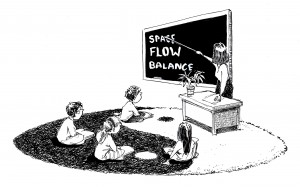A Peaceful Classroom Through Feng Shui

Originally appears in the Spring 2012 issue
“Feng shui, an ancient Chinese discipline, examines the relationships between person and place […] emphasizing how a place will be experienced emotionally and physically…”[i] “Feng,” meaning wind, and “shui,” water, is a 7000 year-old system and practise that purports to help create balance. The foundational principle is that everything has an energy which thus affects the overall feeling and healthfulness of a space, as well as those in a space.
This basic description may seem not only harmless but intuitive and even inarguable. After all, each of us knows what it’s like to feel resonance with a location or environment, or to feel repelled. According to feng shui principles, these feelings come as a result of what’s in the space, or what isn’t, and how it’s all arranged.
Feng shui, however, has had its fair share of controversy. Many of us have had our introduction to feng shui come via television clips and home decorating displays, usually focusing on products for sale that make unlikely claims of being able to increase your wealth or cure your ailments. The result has been a blend of misunderstanding, superstition, and ultimately the loss of potentially helpful ideas that at the very least can help people feel more at ease with their surroundings.
This content is restricted to subscribers only.
If you are not yet a subscriber, please consider taking out a subscription here.
If you are an existing subscriber, kindly log in or contact us at info@greenteacher.com for more information.





